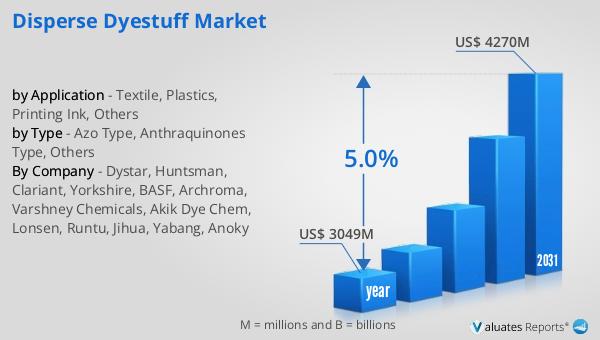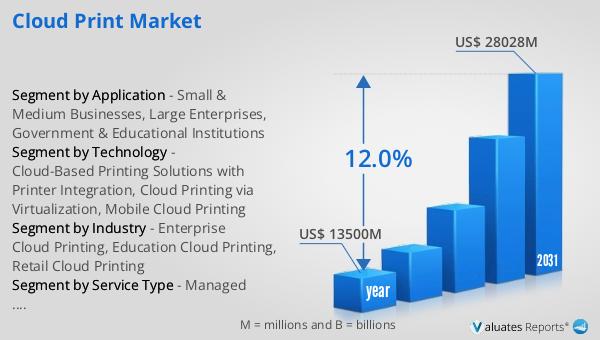What is Global Disperse Dyestuff Market?
The Global Disperse Dyestuff Market is a significant segment within the broader chemical industry, primarily focused on the production and distribution of dyes used for coloring synthetic fibers. These dyes are specifically designed to be insoluble in water, making them ideal for use with hydrophobic fibers such as polyester, nylon, and acetate. The market is driven by the increasing demand for vibrant and long-lasting colors in textiles, which are widely used in fashion, home furnishings, and industrial applications. Disperse dyes are known for their excellent fastness properties, meaning they maintain their color even after exposure to light, washing, and perspiration. This market is characterized by a diverse range of products, each tailored to meet specific requirements of different end-use applications. The growth of the global textile industry, particularly in emerging economies, is a major factor propelling the demand for disperse dyestuffs. Additionally, advancements in dyeing technologies and the development of eco-friendly dyeing processes are contributing to the market's expansion. As consumer preferences shift towards sustainable and high-performance textiles, the Global Disperse Dyestuff Market is poised for continued growth and innovation.

Azo Type, Anthraquinones Type, Others in the Global Disperse Dyestuff Market:
The Global Disperse Dyestuff Market is categorized into various types based on the chemical structure of the dyes, with Azo Type, Anthraquinones Type, and Others being the primary classifications. Azo dyes are the most common type of disperse dyes, characterized by the presence of one or more azo groups (-N=N-) as part of their molecular structure. These dyes are known for their bright colors and are widely used due to their cost-effectiveness and versatility. They can produce a wide range of shades, from yellows and oranges to reds and browns, making them suitable for various textile applications. Azo dyes are also relatively easy to synthesize, which contributes to their widespread use in the industry. However, environmental concerns related to the release of aromatic amines during the dyeing process have led to increased scrutiny and regulation of azo dyes in some regions. Anthraquinones Type disperse dyes are another important category within the market. These dyes are derived from anthraquinone, a polycyclic aromatic hydrocarbon, and are known for their excellent lightfastness and colorfastness properties. Anthraquinones dyes are typically used to produce blue, green, and violet shades, which are highly sought after in the textile industry. The complex molecular structure of these dyes allows for strong interactions with synthetic fibers, resulting in vibrant and durable colors. Despite their higher cost compared to azo dyes, anthraquinones dyes are favored for applications where color stability and resistance to fading are critical. The development of new anthraquinones derivatives with improved environmental profiles is an ongoing area of research, as manufacturers seek to balance performance with sustainability. The "Others" category in the Global Disperse Dyestuff Market encompasses a variety of dyes that do not fit neatly into the azo or anthraquinones classifications. This includes dyes based on different chemical structures, such as nitroarylamine, methine, and quinophthalone dyes. Each of these dyes offers unique properties and advantages, catering to specific needs within the textile industry. For example, nitroarylamine dyes are known for their bright yellow and orange shades, while methine dyes are valued for their ability to produce deep, rich colors. Quinophthalone dyes, on the other hand, are prized for their excellent lightfastness and resistance to sublimation, making them ideal for high-performance applications. The diversity of dye types within the "Others" category reflects the dynamic nature of the disperse dyestuff market, as manufacturers continuously innovate to meet the evolving demands of the textile industry. As environmental regulations become more stringent, there is a growing emphasis on developing dyes that are not only effective but also environmentally friendly, driving further research and development in this segment.
Textile, Plastics, Printing Ink, Others in the Global Disperse Dyestuff Market:
The Global Disperse Dyestuff Market finds extensive usage across various industries, with textiles being the most prominent. In the textile industry, disperse dyes are primarily used for dyeing synthetic fibers such as polyester, which is one of the most widely used fibers globally. The ability of disperse dyes to produce vibrant and long-lasting colors makes them ideal for fashion and apparel applications, where color quality and durability are paramount. Additionally, disperse dyes are used in home textiles, including curtains, upholstery, and bed linens, where they provide aesthetic appeal and resistance to fading. The versatility of disperse dyes allows for their use in a wide range of textile products, from everyday clothing to high-performance sportswear. Beyond textiles, the Global Disperse Dyestuff Market also serves the plastics industry. Disperse dyes are used to color various types of plastics, including polyethylene, polypropylene, and polyvinyl chloride (PVC). The dyes are incorporated into the plastic during the manufacturing process, resulting in uniform and consistent coloration. This is particularly important for consumer goods, automotive components, and packaging materials, where color consistency and stability are crucial. The use of disperse dyes in plastics also extends to the production of colored films and sheets, which are used in a variety of applications, from decorative laminates to protective coverings. In the printing ink industry, disperse dyes are used to produce inks for digital and screen printing applications. These inks are used to print on synthetic fabrics, offering vibrant colors and excellent fastness properties. The ability of disperse dyes to produce sharp and vivid prints makes them ideal for use in the production of banners, flags, and other promotional materials. Additionally, disperse dyes are used in the production of sublimation inks, which are used to transfer images onto polyester fabrics through a heat press process. This technique is widely used in the production of custom apparel, sportswear, and personalized gifts. The "Others" category in the usage of disperse dyestuffs includes a range of niche applications where these dyes provide specific benefits. For example, disperse dyes are used in the production of colored adhesives and sealants, where they provide visual appeal and product differentiation. They are also used in the production of colored rubber products, such as gaskets and seals, where they offer durability and resistance to fading. Additionally, disperse dyes are used in the production of colored coatings and paints, where they provide vibrant colors and excellent coverage. The versatility and adaptability of disperse dyes make them suitable for a wide range of applications, driving their demand across various industries. As manufacturers continue to innovate and develop new dye formulations, the potential applications for disperse dyestuffs are expected to expand, further fueling the growth of the market.
Global Disperse Dyestuff Market Outlook:
In 2024, the global market for Disperse Dyestuff was valued at approximately $3,049 million. Looking ahead, this market is anticipated to grow significantly, reaching an estimated size of $4,270 million by 2031. This growth trajectory represents a compound annual growth rate (CAGR) of 5.0% over the forecast period. This upward trend is indicative of the increasing demand for disperse dyestuffs across various industries, driven by the need for vibrant and durable colors in textiles, plastics, and printing inks. The market's expansion is also supported by advancements in dyeing technologies and the development of eco-friendly dyeing processes, which are becoming increasingly important as environmental regulations become more stringent. As consumer preferences shift towards sustainable and high-performance products, the demand for disperse dyestuffs is expected to continue rising. This growth presents significant opportunities for manufacturers and suppliers within the market, as they seek to capitalize on the increasing demand for high-quality and environmentally friendly dyes. The projected growth of the Global Disperse Dyestuff Market underscores the importance of innovation and sustainability in meeting the evolving needs of consumers and industries worldwide.
| Report Metric | Details |
| Report Name | Disperse Dyestuff Market |
| Accounted market size in year | US$ 3049 million |
| Forecasted market size in 2031 | US$ 4270 million |
| CAGR | 5.0% |
| Base Year | year |
| Forecasted years | 2025 - 2031 |
| by Type |
|
| by Application |
|
| Production by Region |
|
| Consumption by Region |
|
| By Company | Dystar, Huntsman, Clariant, Yorkshire, BASF, Archroma, Varshney Chemicals, Akik Dye Chem, Lonsen, Runtu, Jihua, Yabang, Anoky |
| Forecast units | USD million in value |
| Report coverage | Revenue and volume forecast, company share, competitive landscape, growth factors and trends |
